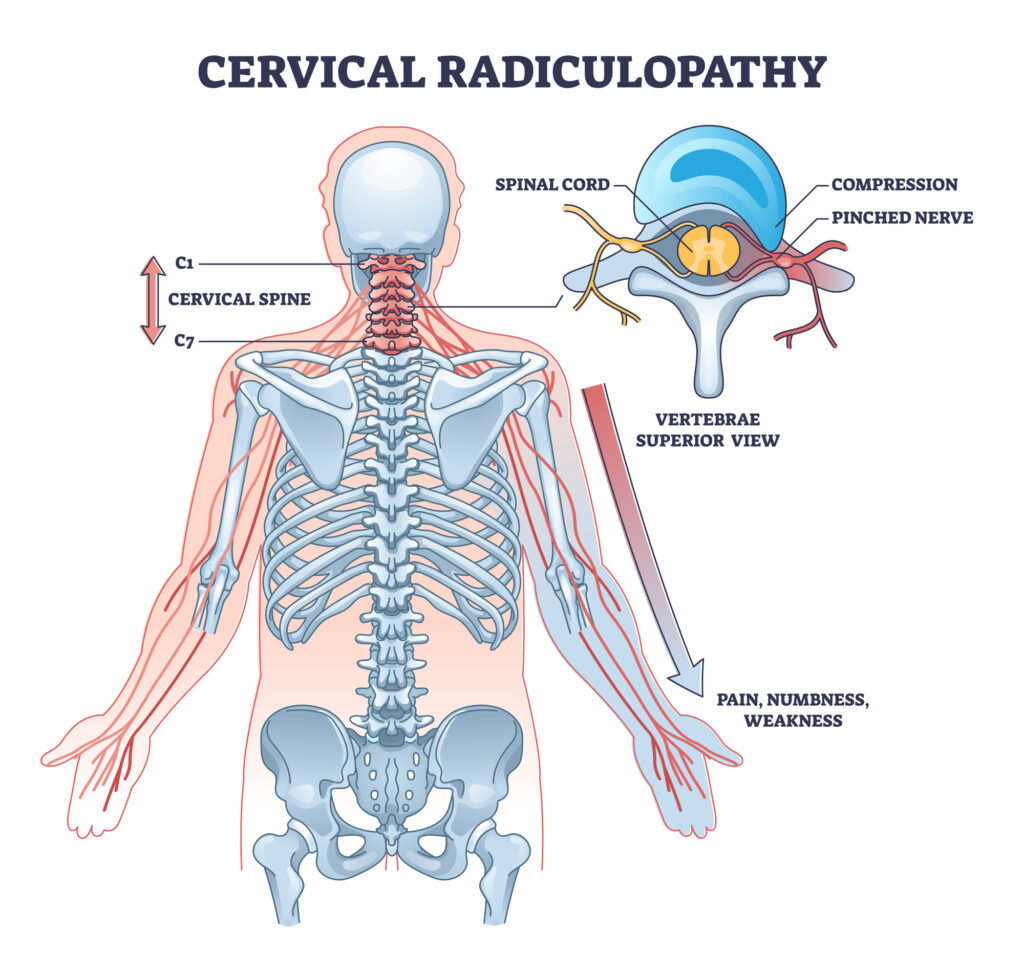Many people facing the prospect of undergoing neck surgery for problems of radiculopathy or numbness and pain radiating into the back, shoulders and arms, have to look at the potential risks, lengthy recovery period, and time away from work and family. For some, regenerative medicine may offer an alternative. Let’s look at some research.
Surgery versus nonsurgical treatment for cervical radiculopathy

An April 2025 study (1) compared surgery versus nonsurgical treatment for cervical radiculopathy. Two randomized clinical trials divided 180 patients with disabling radicular arm pain and cervical disc herniation or spondylosis to receive either surgical or nonsurgical treatment. Surgery involved anterior cervical discectomy and fusion. Nonsurgical treatment involved three sessions with physical medicine/rehabilitation physicians and three sessions with physiotherapists for functional and cognitive behavioral support. The primary outcome in both trials was the Neck Disability Index (NDI) score (range, 0 to 100; higher scores indicate greater disability; minimal important difference is 15) at 12 months, which was self-reported by the patients.
- The researchers found a statistically significant difference for Neck Disability Index (NDI) score at 12 months in favor of surgical versus nonsurgical treatment in the disc herniation trial, but no difference in patients in spondylosis trial.
Comparing regenerative injections, decompression and pain-killer and anti-inflammatory approaches to cervical radiculopathy.
A December 2020 study (2) analyzed the equivocal evidence in support of the effectiveness of each of the three co-existing approaches to conservative treatment of cervical radiculopathy: biological (regenerative), mechanical (decompression) and physical (analgesic and anti-inflammatory). These treatments were compared by dividing 90 patients into six treatment groups.
- Biological treatment: 4 ultra-sound-guided periradicular injections of ACS (Autologous conditioned serum) or PRP (1 per week);
- Mechanical treatment: manual therapy or traction therapy – 8 sessions (two per week);
- Physical treatment: laser therapy or collagen magnetophoresis (the use of a magnetic field in collagen application) – 8 sessions (two per week).
Comparison findings:
- Biological treatments were more effective than mechanical and physical therapies in reducing pain, improving the disability index and proprioception of the hand both immediately on completion of therapy and after a follow-up period, which may suggest their regenerative properties.
- Physical and mechanical therapies produced improvement in the above-mentioned indicators on completion of the therapy, but subsequently exerted a very slight effect during the follow-up period without evident regenerative effects; moreover, a regression of the results was actually recorded for traction therapy. Caution should be paid when using traction therapy in the acute period of root edema, due to possible signs of intolerance of the procedure and exacerbation of the discomfort.
A March 2023 review study however (3) looked at 10,514 studies to see if a comparison could be made between traditional conservative care treatments versus surgical treatment for cervical radiculopathy. Forty-two studies provided baseline motor radiculopathy data, only 22 provided follow-up motor outcomes. The largest group of patient data the researchers had was the group that had surgically-managed motor radiculopathy with unclear pain status. There were no group measurements found for “conservatively-managed painless motor radiculopathy”. The researchers noted: “Large disparities in data quality made direct comparison of conservative vs operative management difficult. . . Many studies fail to report motor outcomes after intervention, meaning statistical evidence to guide optimal management of motor radiculopathy is currently lacking. ”
References
1 Taso M, Sommernes JH, Sundseth J, Pripp AH, Bjorland S, Engebretsen KB, Kolstad F, Zwart JA, Brox JI. Surgical versus nonsurgical treatment for cervical radiculopathy. NEJM evidence. 2025 Mar 25;4(4):EVIDoa2400404.
2 Godek P, Murawski P, Ruciński W, Guzek M. Biological, Mechanical or Physical? Conservative Treatment of Cervical Radiculopathy. Ortopedia, Traumatologia, Rehabilitacja. 2020 Dec 1;22(6):409-19.
3 Gebreyohanes A, Erotocritou M, Choi D. Appraising The evidence for conservative versus surgical management of motor deficits in degenerative cervical radiculopathy. Global Spine Journal. 2023 Mar;13(2):547-62.






